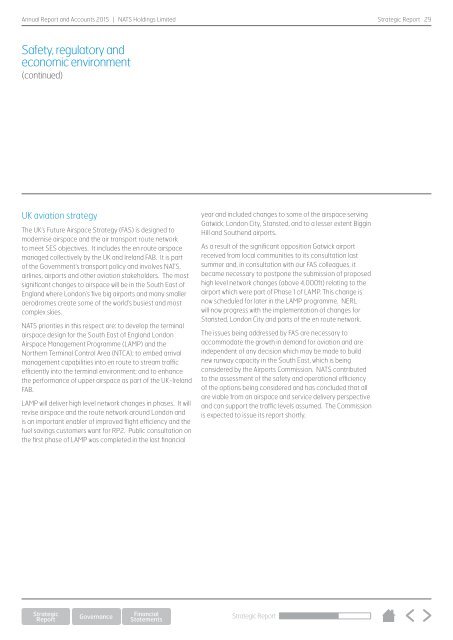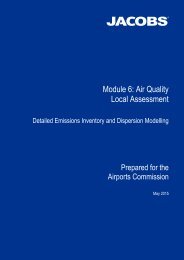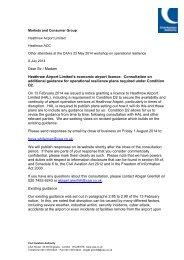NATS-Annual-Report-2015
NATS-Annual-Report-2015
NATS-Annual-Report-2015
You also want an ePaper? Increase the reach of your titles
YUMPU automatically turns print PDFs into web optimized ePapers that Google loves.
<strong>Annual</strong> <strong>Report</strong> and Accounts <strong>2015</strong> | <strong>NATS</strong> Holdings Limited<br />
Strategic <strong>Report</strong> 29<br />
Safety, regulatory and<br />
economic environment<br />
(continued)<br />
UK aviation strategy<br />
The UK’s Future Airspace Strategy (FAS) is designed to<br />
modernise airspace and the air transport route network<br />
to meet SES objectives. It includes the en route airspace<br />
managed collectively by the UK and Ireland FAB. It is part<br />
of the Government’s transport policy and involves <strong>NATS</strong>,<br />
airlines, airports and other aviation stakeholders. The most<br />
significant changes to airspace will be in the South East of<br />
England where London’s five big airports and many smaller<br />
aerodromes create some of the world’s busiest and most<br />
complex skies.<br />
<strong>NATS</strong> priorities in this respect are: to develop the terminal<br />
airspace design for the South East of England London<br />
Airspace Management Programme (LAMP) and the<br />
Northern Terminal Control Area (NTCA); to embed arrival<br />
management capabilities into en route to stream traffic<br />
efficiently into the terminal environment; and to enhance<br />
the performance of upper airspace as part of the UK-Ireland<br />
FAB.<br />
LAMP will deliver high level network changes in phases. It will<br />
revise airspace and the route network around London and<br />
is an important enabler of improved flight efficiency and the<br />
fuel savings customers want for RP2. Public consultation on<br />
the first phase of LAMP was completed in the last financial<br />
year and included changes to some of the airspace serving<br />
Gatwick, London City, Stansted, and to a lesser extent Biggin<br />
Hill and Southend airports.<br />
As a result of the significant opposition Gatwick airport<br />
received from local communities to its consultation last<br />
summer and, in consultation with our FAS colleagues, it<br />
became necessary to postpone the submission of proposed<br />
high level network changes (above 4,000ft) relating to the<br />
airport which were part of Phase 1 of LAMP. This change is<br />
now scheduled for later in the LAMP programme. NERL<br />
will now progress with the implementation of changes for<br />
Stansted, London City and parts of the en route network.<br />
The issues being addressed by FAS are necessary to<br />
accommodate the growth in demand for aviation and are<br />
independent of any decision which may be made to build<br />
new runway capacity in the South East, which is being<br />
considered by the Airports Commission. <strong>NATS</strong> contributed<br />
to the assessment of the safety and operational efficiency<br />
of the options being considered and has concluded that all<br />
are viable from an airspace and service delivery perspective<br />
and can support the traffic levels assumed. The Commission<br />
is expected to issue its report shortly.<br />
Strategic <strong>Report</strong>






